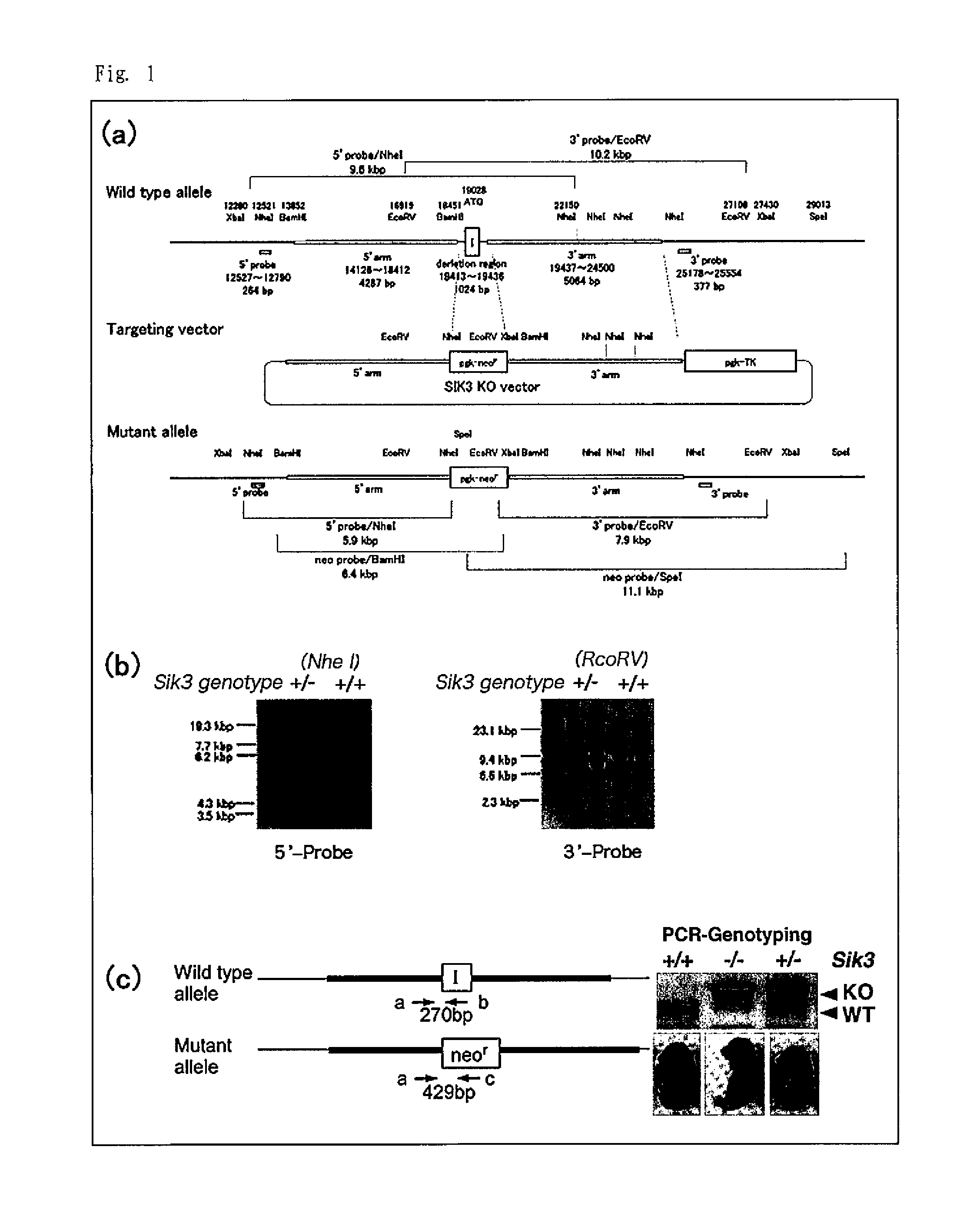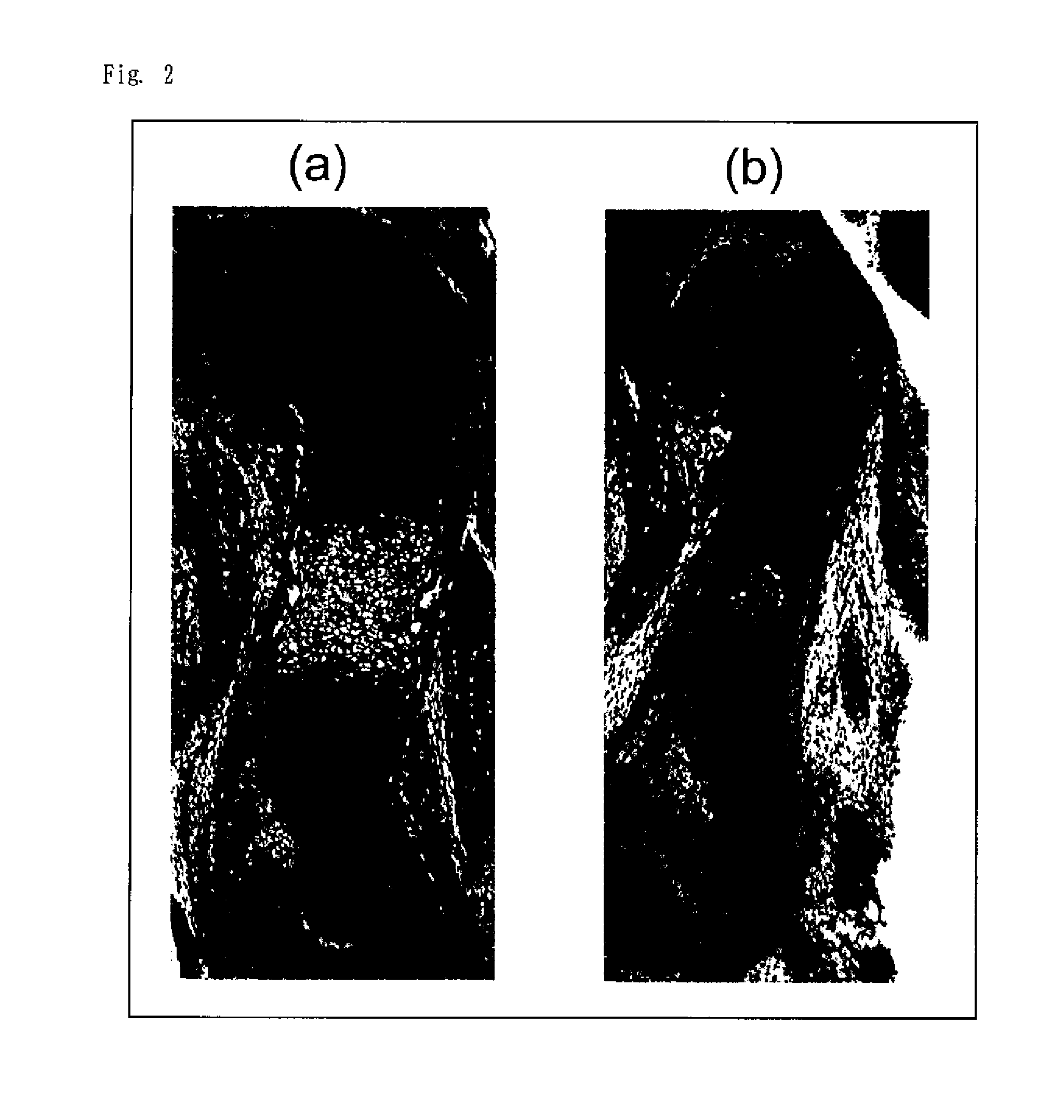Screening method for therapeutic agent for chondropathy and modified chondrocyte for treatment of chondropathy
a technology of chondropathy and chondrocyte, which is applied in the direction of drug compositions, skeletal/connective tissue cells, instruments, etc., can solve the problems of hypertrophy of cartilage-like cells induced from stem cells, and achieve the effect of reducing cartilage volume and reducing cartilage volum
- Summary
- Abstract
- Description
- Claims
- Application Information
AI Technical Summary
Benefits of technology
Problems solved by technology
Method used
Image
Examples
reference example 1
Analysis of Chondrocyte Differentiation in SIK3 Knockout Mice
(1) SIK3 Knockout Mice (Hereinafter Referred to as “SIK3 KO Mice”)
[0068]A targeting vector carrying, in consecutive order from the 5′ end to 3′ end, the 5′-end genome sequence of the mouse SIK3 gene (5′ arm), a pgk promoter, a neomycin resistance gene, and the 3′-end genome sequence of the mouse SIK3 gene (3′ arm) (see FIG. 1 (a)) was generated in accordance with a usual method. The obtained targeting vector was introduced into mouse ES cells and the cells were cultured in G418-containing medium to generate neomycin-resistant ES cells. DNA was extracted from the obtained neomycin-resistant ES cells and homologous recombinant clones were identified by southern blot analysis (see FIG. 1 (b)).
[0069]The obtained homologous recombinant clones were microinjected into blastocysts obtained from BDF2 mice, and the manipulated blastocysts were implanted into the womb of mice. The mice that conceived after the implantation gave birth...
reference example 2
Rescue Test Using SIK3 Transgenic Mice
(1) SIK3 Transgenic Mice (Hereinafter Referred to as “SIK3 Tg Mice”)
[0078]A transgene construct was generated by linking a human SIK3 cDNA (Accession No. NM_025164) to a promoter / enhancer for the α2(XI) collagen chain gene (Col11a2), which directs cartilage-specific expression (Tsumaki N, et al. J Cell Biol. 1996; 134: 1573-1582). This transgene insertion was cut from the vector backbone, purified, and then microinjected into mouse fertilized eggs. The eggs were implanted into the oviduct of pseudo-pregnant mice. From the mice produced from the pseudo-pregnant mice, SIK3 Tg mice were selected and thus a SIK3 Tg mouse line was established. The genotype of the fetuses or the newborns was confirmed by PCR using the genomic DNA extracted from the tail or ear tissue. The following primers were used for the PCR.
[0079]
(SEQ ID NO: 7)Forward primer: 5′-GATGTCGGATGCAGTTCTC-3′(SEQ ID NO: 8)Reverse primer: 5′-ATGTCTGTAATACACGTAGATGGATA-3′
(2) Test Method
[008...
reference example 3
Observation of Growth Plate of Knee Joint of SIK3 Transgenic Mice
[0084]Three-, six-, and eight-month-old SIK3 Tg mice and wild-type (WT) mice were euthanized by carbon dioxide inhalation and dissected for harvesting the forelimbs and hindlimbs. The harvested limbs were fixed in formalin and then decalcified in EDTA. Next, sections were produced and stained in the same manner as in Reference Example 1.
[0085]The obtained specimens were observed under an optical microscope. FIG. 6 shows histologically stained sections including the knee joint of each of the 3-, 6-, and 8-month-old mice. The left is the wild-type mice (“Wt” in the figure) and the right is the SIK3 Tg mice (“LI-hSIK3 Tg” in the figure). As is apparent from FIG. 6, the growth plate was observed in both of the wild-type mice and the SIK3 Tg mice at 3 months old, but the growth plate disappeared from the SIK3 Tg mice at 6 and 8 months old, while the growth plate in the wild-type mice was observed at 6 and 8 months old.
[0086...
PUM
| Property | Measurement | Unit |
|---|---|---|
| volume | aaaaa | aaaaa |
| stiffness | aaaaa | aaaaa |
| Tg | aaaaa | aaaaa |
Abstract
Description
Claims
Application Information
 Login to View More
Login to View More - R&D
- Intellectual Property
- Life Sciences
- Materials
- Tech Scout
- Unparalleled Data Quality
- Higher Quality Content
- 60% Fewer Hallucinations
Browse by: Latest US Patents, China's latest patents, Technical Efficacy Thesaurus, Application Domain, Technology Topic, Popular Technical Reports.
© 2025 PatSnap. All rights reserved.Legal|Privacy policy|Modern Slavery Act Transparency Statement|Sitemap|About US| Contact US: help@patsnap.com



